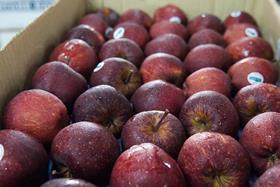
India’s apple growers are failing to capitalise on their vast domestic market that could easily consume 4.7m tonnes more fruit than they are currently producing.
So says horticultural marketing professional Vipul Mittal. Writing for India’s Hindu Business Line on Monday, Mittal said that if 10 per cent of India’s 1.2bn population subscribed to the adage “an apple a day keeps the doctor away” it would require a volume of some 6.5m tonnes of fruit to feed them, based on an average apple weighing 150g.
“That’s a whopping 4.7m tonnes more `apples` than the 1.8m tonnes produced annually by `India`,” wrote Mittal. “This 4.7m tonnes gap is a big opportunity we somehow seem to be missing, even while the world is not.
“During the last five years, our apple production has remained almost constant and nothing appears to be changing on this front. Compare this with China, which has raised its output by 5m tonnes over this period, despite being the world’s largest producer at 32m tonnes.”
Indeed, China – together with the US – has been one of the two leading sources of imported apples for India, which are growing apace as global suppliers capitalise on swelling consumer demand fuelled by rising affluence levels.
According to Mittal, India imported some 140,000 tonnes of apples in 2010/11 (September to August), which, at an average landed cost of US$25 per 20kg carton, would have been worth US$175m. He estimated that over half of those apples come from Washington State, which saw its sendings soar by 140 per cent last season.
The rise of apple imports has nevertheless brought several valuable lessons and benefits for local suppliers, Mittal argued.
Firstly, it has shown growers and traders that the customer is ready to pay a premium for good, consistent-quality fruit, he said. Secondly, that the use of tray-packed telescopic cartons `rather than wooden boxes` allows for the fruit to be transported long distances with minimal wastage. Thirdly, that price volatility can be reduced considerably when fruit is properly sorted, graded and packed. And fourthly, that the consumer is willing to eat an apple everyday, irrespective of the season, providing it’s readily available.
“What needs to be done now is to leverage these valuable lessons to convert the 4.7m-tonne gap into an opportunity for our own growers,” Mittal continued.
Working through the supply chain, he identified a number of areas in need of attention. The Indian industry must focus on planting new varieties and improving productivity and quality. It needs to implement scientific post-harvest practices to standardise production; invest in complete marketing programmes, including brand development, to compete effectively against global competition; and develop proper packaging and supply chain infrastructure.
More specifically, Mittal called on institutional bodies such as Himachal Pradesh Horticultural Produce Marketing & Processing Corporation (HPMC) to address these issues and modernise their strategies.
“HPMC’s failure, one would argue, is not having a vision to keep pace with time,” he said. “There can be no better indicator of this than the fact that the HPMC today does not have a single CA storage facility to store fresh apples over long periods, thereby helping growers realise more value for their produce. How can one expect HPMC to give remunerative prices to the grower, if it doesn’t have the holding capacity to effectively intervene in the market?”
Mittal suggested the HPMC, and the Indian apple industry overall, can learn lessons from the work of the National Dairy Development Board (NDDB), which pioneered the development of an organised dairy industry in the country under the leadership of Dr Verghese Kurien.
“The latter created models to collect milk from various small producers, which he converted into strength rather than a limitation through the now well-known 'Anand pattern' of dairy cooperatives,” wrote Mittal. “The apple industry, too, needs to figure out similar viable models of organising apple growers.”
Just as the dairy industry has become the largest employer in India’s agriculture sector, Mittal noted that apple production could generate sustainable jobs for a large number of youth in Jammu & Kashmir, Himachal Pradesh, Uttarakhand and the Northeast region of India. This, he said, would improve their income generation prospects and help to solve social and related problems.
'It's time that policy makers examined this apple-a-day opportunity and created an institutional framework to increase India's productivity as well as competitiveness in the global apple trade,' Mittal concluded.



